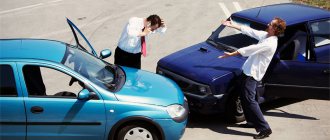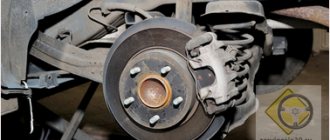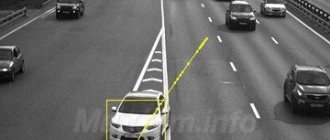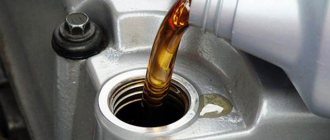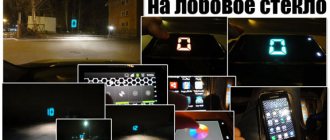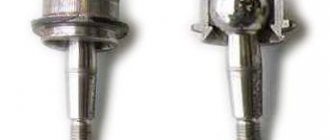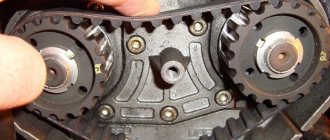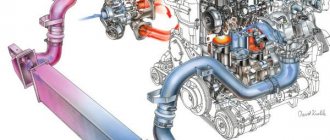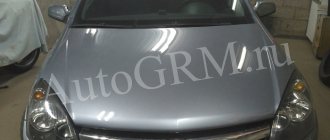Concept of obstacles on the road
To understand in what situations it is possible to avoid an obstacle, you need to understand the definition itself. In accordance with the traffic rules, an obstacle is an immovable object that is located on the roadway.
Obstacles include:
- Defective vehicles that are located in the traffic lane and cannot continue moving;
- An object that blocks traffic on the roadway and creates an emergency situation on the road;
- Repairs carried out on a specific section of the road.
In accordance with the traffic rules, if a car is parked on the road, then it is not an obstacle and driving around it through a solid marking line is prohibited.
Detour fines in 2020
Violations related to crossing road markings in the form of a solid line are a very common administrative violation.
Whether it is done intentionally or out of ignorance does not matter, the responsibility is the same, since it is strictly prohibited.
With this violation, there are many controversial situations; let’s further consider what they are and what fines are provided for this.
7 Moscow St. Petersburg
Show content
Although the fine for improper overtaking is large, its size cannot be compared with the fine for improper overtaking (deprivation of rights for 4-6 months).
Let's consider situations in which questions most often arise regarding the implementation of a detour.
How to go around an obstacle correctly
When a vehicle driver sees an obstacle in a traffic lane, he must perform the following actions:
- Assess what is happening on the road, make sure that the obstacle is not a temporary traffic jam.
- After making sure that the obstacle is present, go around it. It is advisable to detour, sticking to the right lane or shoulder. You are not allowed to drive onto the sidewalk.
The most correct course of action when an obstacle is detected is to notify the traffic police. The detour itself is carried out after police officers arrive at the scene and receive recommendations from them about the traffic order on this section of the road.
If the police cannot arrive promptly, then to prove the validity of driving into oncoming traffic, the driver can record the process of driving around on a DVR or mobile phone camera.
Trajectories when turning left
Thus, the fine for crossing a solid or double solid road when making a left turn is 1,000 - 1,500 rubles.
If, when turning left, the car is at least partially in the oncoming lane, the punishment for crossing a solid marking line will be more severe - 5,000 rubles or deprivation of rights for 4-6 months.
Thus, the size of the penalty mainly depends on the trajectory of the vehicle. Later in this article, various options for performing a turn will be discussed.
To better understand the details of the situation, below are diagrams for making a left turn on two road options:
- two-lane with a continuous line marking,
- four-lane with double solid line.
two lane road
If you look closely at the picture, it becomes clear that the left side of the car, when turning, ends up in the oncoming lane. This is especially noticeable on the rear left wheel. When making a turn along such a trajectory, the driver will face a fine of 5,000 rubles or deprivation of his license.
The figure above illustrates such a maneuver. However, it becomes obvious that on a road with two lanes such a maneuver is very difficult, almost impossible. There is not enough room to turn after crossing a continuous road. Therefore, in any case, when turning, the driver will partially drive into the oncoming lane.
In this case, it is even clearer that if the driver cuts the corner, he ends up in the oncoming lane. The punishment for such a maneuver will be a fine of 5,000 rubles or deprivation of rights for 4-6 months.
On a four-lane road, there is plenty of space so the driver can first cross the double solid line markings and only then turn the steering wheel to the left. In this case, he will receive a fine of 1,000 - 1,500 rubles.
Let's summarize this article. To receive the minimum penalty when turning left, you must cross a solid (double solid) marking line at a right angle. Other driving trajectories may result in the driver receiving a license deprivation for driving into the oncoming lane.
In conclusion, I would like to note that this article was written in connection with a large number of questions from readers about crossing a solid line when turning left. In practice, it is much safer to first turn right and then turn around at the nearest intersection.
Good luck on the roads!
The set of provisions that regulates fines and other types of punishment for administrative offenses is regulated by the Code of Administrative Offenses of the Russian Federation.
According to part one of Article 12.16 of the Administrative Code, driving through a solid line in the same direction without complying with the requirements of road markings 1.1 entails a warning or a fine of 500 rubles.
For example. On a 4-lane road, the driver of a passenger car (A) decided to overtake a cargo vehicle (B) in front of the bridge. To the left of it is a horizontal marking 1.1, indicating the prohibition of crossing. Driver A crossed the solid marking line while passing! direction, but he committed this action in violation of traffic rules. Therefore, he will face punishment in accordance with Part 1 of Art. 12.16 Code of Administrative Offenses of the Russian Federation.
When turning through a solid lane 1.1 in order to change lanes in another direction from 1000 to 1500 rubles, Art. 12.16, part 2.
To determine the penalty for crossing a solid line, it is necessary to take into account the classification of the markings. According to state standards, lines are divided into:
- horizontally located (indicated by index 1);
- vertical (2).
The second digit of the marking indicates the number, the third - the type. The following solid marking lines stand out:
- single (1.1) – separating zones of oncoming traffic;
- similar to 1.1, but larger in width (1.2.1) - applied along the edge of the roadway;
- double (1.3) – dividing the roadway into passing flows (2 or more on each side);
- single yellow (1.4) – designation of places with prohibited parking;
- solid, accompanied by a dashed line (1.11) – allows intersection from the dashed side;
- single transverse (1.12) – at the place where the vehicle is required to stop in front of a traffic light or STOP sign.
The types of intersections of continuous marking lines are not classified by the provisions of the road legislation, but certain circumstances are highlighted in which the type of line establishes the priority of passage.
Leaving the yard
When leaving the yard through the solid near line, 1.2.1 turns into 1.2.2. Continuous intersects when turning right through lane separation. The driver must let all vehicles pass, including cyclists, as well as pedestrians, regardless of which direction they are moving from.
Road markings are designed to separate traffic flows.
This requirement of the rules creates a problem if the motorist, when driving through a continuous road, incorrectly calculated the distance and driving speed of the car approaching in the opposite lane.
A little terminology.
An obstacle is the presence of stationary objects on the roadway that impede progress:
- broken down cars and other equipment;
- ditches, holes, failures, etc.;
- foreign objects (fallen trees, large stones, fencing elements, etc.).
But they are not:
- minibuses, trolleybuses and other types of passenger transport that drop people off;
- traffic jams;
- static people or machines:
- puddles, accumulations of rubble, ice and other obstacles that allow passage.
It is necessary to go around a stationary obstacle on the right side, and only if this is impossible - on the left.
When performing repairs or other work within the roadway, vehicles are directed according to the established signs.
Driving beyond a continuous single or double line involves entering the zone of oppositely directed traffic flow, which can create an emergency situation. Rotation is allowed in the designated places where the solid line is replaced by a dashed line.
Overtaking
It is prohibited to cross solid marking lines when overtaking. Exceptions are allowed in two non-standard cases:
- bypassing vehicles classified as low-speed, but only in an area where overtaking is prohibited by an appropriate sign. The vehicle's status as a low-speed vehicle must be confirmed by the established designation;
- at an intersection that prevents an accident, to prevent a collision with another car, injury to a pedestrian, etc.
When overtaking, it is prohibited to cross a solid marking line.
Previously, it was allowed to cross a continuous line while overtaking if the maneuver started from a dashed line. Currently, current traffic regulations prohibit such actions. The driver must begin and complete overtaking within the boundaries of the dashed line.
When driving through the marking line and moving to the second row, the line separating opposite flows in directions – 1.1, 1.3 – is crossed, which is prohibited by the rules. In other situations, the action does not involve crossing a solid dividing line.
When changing lanes, drivers must give way to vehicles moving in the right lane.
Penalties for changing lanes across a solid line at intersections are illegal if the driver is forced to move to the right lane when the car ahead suddenly turns. But it is necessary to distinguish between the concepts of changing lanes and overtaking across a continuous road, which is not permitted in this case.
According to the definition of clause 1.3 of the traffic rules, a double solid line is a strip separating opposite traffic flows on roads with four or more lanes.
As for the penalty for crossing a double solid line, it is similar to the penalty for crossing a single line.
That is, the most severe sanctions will be applied to the driver if he crossed this line while overtaking - a fine of 5 thousand rubles, or he will be deprived of his license for 4-6 months in case of a primary violation, and for repeated violations - for 1 year.
By driving around an obstacle in violation of this rule, the driver will be subject to a penalty of 1 thousand - 1.5 thousand rubles, the same threatens drivers for committing this violation when turning or turning.
If you entered a dedicated lane and crossed a double solid lane, you will receive a fine of 1.5 thousand rubles.
For other cases, you can get off with a warning, or pay a minimum fine of 500 rubles.
When is passing on oncoming traffic allowed?
In some situations, crossing a continuous dividing strip is possible even with a sign prohibiting overtaking.
This can be done in the following cases:
- Intermittent markings are applied to the road surface;
- A slow-moving vehicle is being overtaken (it must have the appropriate symbol installed on it);
- If a driver overtakes a scooter, bicycle, or horse-drawn cart.
The group of low-speed vehicles includes all vehicles whose speed does not exceed 30 km/h.
In some situations, the presence of an obstacle ahead of traffic is signaled by signs installed along the road or temporary traffic lights. They signal where it is necessary to perform a maneuver to avoid an obstacle.
Installation of such signs and traffic lights occurs in the following cases:
How to appeal the confiscation of a driver's license for crossing a solid line
The driver has the right to appeal the deprivation of rights or the imposition of other sanctions for incorrectly crossing a continuous line in the event of unlawful actions of traffic police representatives. But a successful resolution of the issue is only possible if there is appropriate evidence.
If the drawn line is erased and is not visible enough due to snow, ice and other contaminants, the driver has the right to challenge the decision to impose a fine for crossing a solid road into the oncoming lane before a traffic police inspector or in court. But it is necessary to provide video evidence of insufficient visibility of markings or supporting testimony.
In this case, reasoned evidence will also be required indicating the impossibility of imposing a fine for crossing a solid line. Without documentary evidence it is impossible to argue your own arguments.
Forgery
Traffic police inspectors often misinterpret the rules. The driver is charged with a violation under an article that provides for a more severe degree of liability for the offense committed. The motorist must convincingly prove the incorrect interpretation of a specific article of the rules and not sign a protocol for violation of driving beyond the solid line.
A court decision based on false evidence can be appealed within ten days after the decision is approved. To do this, the defendant presents written arguments, photographs or videos proving the unlawfulness of the punishment. The papers are submitted in two copies: one to the court office, the other remains with the applicant.
The motorist needs to familiarize himself with the protocol drawn up in detail. Errors or inaccuracies will serve as additional grounds for postponing or suspending the trial.
Expert opinion
Mironova Anna Sergeevna
Lawyer and lawyer for automobile law. Specializes in administrative and civil law, insurance.
Hiring a legal consultant will increase your chances of winning your case. The fact of a violation recorded by automatic video recording serves as an additional basis for reviewing the case in court or proving innocence.
Knowledge of the rules significantly increases a motorist’s chances of avoiding accidents and protects against an unreasonable fine from a traffic police representative.
Dear reader!
The article provides basic information, but most cases are individual in nature. In this connection, our website employs on-duty lawyers whom you can contact by phone:
- Moscow ext 104
- St. Petersburg ext 104
- All regions ext 289 (Toll free)
When you contact us, you will receive advice specifically on your problem.
- Carrying out road work in the vehicle traffic area.
- There was an accident on the road that requires a long investigation.
- Public transport is operating in the area where vehicles are moving, making travel difficult.
- Maintenance of lighting along the road is being carried out.
The driver must strictly follow the direction the road signs indicate. In this case, crossing a solid marking line will not constitute a violation.
Immediately after the cause that necessitated the need for vehicles to move into oncoming traffic has been eliminated, the road signs are removed and traffic proceeds as normal.
Avoiding an obstacle through a solid marking line
Avoiding an obstacle through a solid line marking 1.1 in any case is a violation of traffic rules. In this case, 3 types of punishment are possible.
A warning or an administrative fine in the amount of 500 rubles, in case of making a detour without entering the lane of oncoming traffic. In this case, it does not matter whether you are driving around an obstacle or a bus that has stopped according to the rules, which is not an obstacle. In any case, a fine will be imposed for failure to comply with road markings.
Obtaining a driver's license after being deprived of a solid line
First of all, it must be said that if you are deprived of your license during the first three days after the trial, you must submit not only your driver’s license, but also a temporary permit, if you have one. Those who try to avoid punishment in this way will only prolong their term of imprisonment.
The first thing you need to get your license back after being deprived of it for crossing a solid road is to pick up a copy of the court order and a document that confirms that you handed over the license to the inspector. You can pick it up the very next day after the period of deprivation expires, the beginning of which is counted from the day the rights are transferred to the traffic police department. For this you need the following documents :
- Passport.
- A document issued by the inspector upon seizure of the certificate.
- A copy of the court order.
According to the latest amendments, the driver, when picking up his license, is not required to have a medical certificate with him, however, it is recommended to take it as well, since traffic police officers often require this document as well. Their actions can be challenged in court, but this will take more time than issuing a medical certificate.
To get your driver's license back, you must pay all fines. As long as you have unpaid fines, you will not be able to regain your right to drive.
An inevitable part of returning your license is also a re-exam on the theory of the Road Traffic Rules. You should approach this responsibly: a retake is possible only after 7 days. It is impossible to take away your license legally without passing the exam.
After the period for deprivation of your driving license has expired and the fines have been paid, you can pick up your license at the traffic police department where you left it, and pass the exam there. The procedure rarely takes more than one day.
The return of rights after their deprivation in another city differs little. You can either go to the traffic police department where you submitted the document, or contact your institution, from where a request for return will be submitted. Your license will be delivered to the office at your place of residence, but this will take up to two weeks.
From all that has been said, we can conclude that the procedure for restoring a driver’s license is quite simple and consists of the following stages:
- Submission of the documents provided for in this case.
- Passing the exam on traffic rules theory.
- If there are fines, pay them.
- Driver's license restoration.
Horizontal road markings are the most important element of traffic regulation, and due to neglect of its requirements in the case of a continuous line, it is possible to remain without a license for an impressive period. It is in the interests of drivers to know the penalties for certain violations, but it is definitely better to be attentive and careful on the road so that no trouble arises at all.
- About
- Latest Posts
Automotive lawyer. He has his own law office, specializes in issues related to road accidents, and protects clients in the event of drawing up reports by traffic police officers. An expert in the rules of conduct with a traffic police officer, the nuances of drawing up a protocol and the inalienable rights of a driver.
Where to apply
DR is applied in certain places. Basically, most of the questions arise about continuous markings placed in the middle of the road.
In the center of the roadway
The following DR can be applied in the center of the road:
- 1.;
- 3.;
- 11.
The main and most common type of DR is 1.1 (the so-called “single solid”).
Its main functional purpose:
- divide traffic flows moving towards each other;
- mark the boundaries of lanes for driving on unsafe sections of the road.
Note that 1.1. may only be applied in the middle on roads with two or three lanes in both directions. The classic situation is a highway with 1 lane for driving in each direction.
If there are 2 or more lanes (hereinafter also referred to as rows) for driving in each direction, as well as when the width of the lanes is higher than the established value (see below), another DR is applied - 1.3. (the so-called “double solid”).
In addition, 1.1. used on three-lane roads on which the middle lane is used by motorists in both directions (for overtaking, detours, when turning, etc.).
However 1.1. used on these two- or three-lane roads not along their entire length. Otherwise, drivers would not be able to perform maneuvers such as overtaking or avoiding obstacles, because 1.1. strictly prohibits crossing it (details below).
Accordingly, road workers, on instructions from the municipal administration, apply 1.1. only in places where:
- there is limited visibility. From clause 1.2. The Rules know that limited visibility is visibility limited by the geometric parameters of the road, terrain, vegetation, artificial structures, etc. Limited visibility can also be observed on steep descents, ascents, and dangerous turns. In this case, in addition to continuous markings, the driver is warned about the corresponding danger by road signs - 1.12.1., 1.12.2., 1.13. and 1.14.;
- when approaching intersections, railway crossings, pedestrian crossings or intersections of roadways with bicycle (pedestrian) paths.
Most maneuvers are prohibited in these areas. So, for example, at pedestrian crossings, at intersections regulated by traffic lights, and also closer than 100 meters from railway crossings, you cannot overtake (clause 11.4 of the Rules).
At pedestrian crossings and near railway crossings, you also cannot turn around and drive in reverse (clauses 8.11 and 8.12 of the Rules).
In order to limit the performance of these maneuvers and to improve overall traffic safety, markings 1.1. applied near such areas.
On the edge of the road
Along the edge, not only a yellow solid line is applied, signaling the impossibility of stopping, but also a white 1.2., which is applied along the edge along the roadway and separates the main road where vehicles are moving from the side of the road.
It is allowed to drive onto this line when entering and exiting the roadside - but only on the condition that stopping and parking at this entry and exit point is permitted in accordance with Section 12 of the Rules.
For example, if there is no sign 3.27., then you can park the car in a populated area on the right side of the road - and it doesn’t matter that the side of the road is separated by a continuous line 1.2.
Or, for example, cross 1.2. it is possible if it is applied along the left side of the road, if:
- no 3.27.;
- the stop is made in a populated area;
- missing markup 1.1. or 1.3.;
- there are no tram tracks in the middle.
Also at the edge of the road the above 1.1 can be applied. However, unlike 1.2., 1.1. never divides the main roadway from the curb.
If a motorist saw 1.1. on the edge of the road, this will mean only one thing - the markings are applied to indicate the boundaries of the guide island. Additionally, the islands are designated 1.16.1., 1.16.2. and 1.16.3.
As in other cases, 1.1. will prohibit crossing it and going to the corresponding confluence zone.
Along the tram tracks
The possibility or impossibility of hitting a solid road along tram tracks will depend on where it is located.
As a rule, tram tracks in the same direction and in the opposite direction are located next to each other in the middle of the road.
Accordingly, the continuous one can be drawn:
- or between oncoming and passing tram tracks;
- or between the leftmost car lane and the passing tram line (see pictures).
It is not entirely clear who may need to apply a continuous line between tram tracks, because driving into oncoming traffic in such cases is already prohibited by the Rules (clause 9.1.1.).
In addition, it is not allowed to drive onto oncoming tram rails in any cases - regardless of the number of lanes and other factors (clause 9.6 of the Rules).
Essentially, the presence or absence of 1.1. or 1.3. between tram tracks does not affect anything.
It’s a different matter when a continuous line is applied between the passing rails and the lane for vehicle traffic. A comment on this was given by the traffic police of the Ministry of Internal Affairs of the Russian Federation for Yekaterinburg - such a line can be crossed.
The purpose of such an DR is to show the driver the dimensions of the tram so that the movement of road transport does not interfere with it.
Thus, having seen a continuous line between the rails and the traffic lane, the driver may well cross it and move along the passing tram rails, taking into account clause 9.6.
That is:
- you cannot occupy tram rails when there are free car lanes;
- but left turns should only be made from tram rails, with the exception of signs 5.15.1. or 5.15.2. regulate the implementation of these maneuvers from certain lanes.
At a public transport stop
Public transport stops are marked with marking line 1.17. This DR is a yellow zigzag (see picture).
In addition, stopping places are also indicated by signs:
- 16. – for buses or trolleybuses;
- 17. – for trams.
A continuous line is applied if it is necessary to separate a dedicated strip, indicated by signs 5.11.1., 5.13.1., 5.13.2. or 5.14., from the rows intended for the movement of other vehicles.
In addition to signs, a dedicated lane for public transport is also indicated by a special DR 1.23.1. in the form of a capital letter “A”.
It doesn’t matter whether a continuous or broken line separates the dedicated lane from the rest - in any case, movement on this dedicated lane is prohibited (clause 18.2 of the Rules).
Exception: if there is a broken line, the following maneuvers are permitted:
- changing lanes to turn right;
- parking for pick-up or drop-off of citizens (provided that this does not interfere with route vehicles).
As you can see, if the selected lane is separated by a solid lane, neither movement, nor changing lanes, nor performing any maneuvers on it are allowed.
The rules for transporting children by railway transport without parents in Russia are discussed in the article: rules for transporting children of Russian Railways. Read about the features of transporting a motorcycle to Europe here.
Double solid
Double continuous is two single solid lines drawn side by side parallel to each other.
The functional purpose of a double solid one is much narrower than that of a single one. The double one is not applied in places where entry is prohibited (safety islands, confluences of streams, etc.), does not mark the boundaries of parking spaces, is not applied in areas with limited visibility, etc. All these functions are performed by a single solid one.
But the double, just like the single, divides the opposite flows of cars.
However, unlike single, double is applied only in specified cases, namely:
- or on roads that have more than 4 lanes for traffic in both directions;
- or on roads with 2 or 3 lanes - provided that the width of the lanes is more than 3.75 meters.
Penalties for illegally driving through continuous lines according to the law
Administrative sanctions for incorrectly driving on a continuous road in violation of traffic rules, as well as for other incorrect actions of motorists, are determined by the provisions of the Code of Administrative Offenses of the Russian Federation.
The amount of the fine for changing lanes through a complete ban or the duration of the driving ban depends on the number of offenses committed and the severity of the consequences of a possible accident.
The following measures are provided:
- when driving beyond a solid marking line in the same direction;
- when leaving the yard space through a continuous road.
We invite you to read: How to sign up to take the exam at the State Traffic Safety Inspectorate 2020, how to sign up to take your license through State Services
The choice between an oral reprimand or a fine in the prescribed amount remains with the traffic police inspector, who takes into account the degree of danger of the consequences.
For crossing a solid marking line, administrative sanctions are imposed on the driver.
A receipt with a fine of one to one and a half thousand rubles is issued to the violator if:
- U-turns or left turns;
- avoiding obstacles followed by a U-turn;
- changes at road intersections. In addition to crossing a solid line, the violator will be additionally punished for performing a maneuver in an unauthorized place - at an intersection;
- incorrect changes.
A five thousand fine for violations or confiscation of a driver’s license is based on:
- for driving into oncoming traffic, including tram tracks (without revocation of rights);
- in case of overtaking, even if the maneuver began in the same direction as the other car, away from the broken line - both of the listed measures of influence;
- when hitting a solid road without crossing it - in a similar manner.
If a motorist hits a solid line with one wheel, a fine is charged in the amount of not five, but one and a half thousand rubles. But inspectors often ignore these differences in legislation.
It is difficult for a motorist to refute such unreasonable actions of a traffic police representative with arguments. In such a situation, an experienced auto lawyer will help. DVR information will not hurt as evidence.
Prohibition of permission to drive a car is legal when the driver crossed a solid line, overtaking, or drove along tram rails in the opposite direction, as well as in the case of a turn to the left before crossing a broken line.
Confiscation of a driver's license is illegal in the following cases:
- crossing the dividing line in a critical situation to prevent an accident;
- hitting the demarcation line with one wheel;
- leaving a gas station or parking lot adjacent to the road;
- hitting a demarcation strip dividing the oncoming direction;
- making a U-turn onto a solid line.
The listed violations imply administrative punishment in the form of a fine in the amount of one thousand Russian rubles.
- Changing lanes in a different direction. A situation that occurs quite often on our roads. The driver, without waiting for an intersection or a turn, an intermittent line, hurries to change the direction of movement and crosses a solid line. Let us remind you that for such an act he will face a fine ranging from 1000 to 1500 rubles. according to Art. Code of Administrative Offenses 12.16, part 2.
Attempt to overtake. The driver, neglecting traffic rules, overtakes, enters the oncoming lane and crosses the solid lane 1.1. For such a violation in accordance with Part 4 of Art. 12.15 Code of Administrative Offenses will be 5,000 rubles or deprivation of rights for crossing a continuous road for 4-6 months.
- An attempt to avoid an existing obstacle. Often, drivers encountering obstacles on the roads in the form of broken down cars, repair work, cross a continuous lane into the oncoming lane. This administrative violation is subject to punishment, which is regulated by Part 3 of Art. 12.15 Code of Administrative Offenses - a fine of 1000-1500 rubles.
Important: it doesn’t matter what is being crossed - a double and a single solid line are equivalent markings, the intersection of which is strictly prohibited.
The most common controversial situations, as well as ways to avoid punishment in them, are:
- The markings are erased, blurred and difficult to see. This situation is very common on Russian roads due to the fact that it is applied quite rarely. This circumstance, especially confirmed by photo and video materials, can become direct evidence of innocence.
- If there was a collision with one wheel on the marking line. In this case, there was no fact of crossing a continuous strip, and therefore a completely different preventive measure is applied - 1,500 rubles for violating the position of the car on the roadway (even a minor collision of 1 cm is considered a violation).
- Crossing a solid lane when leaving a parking lot. The fine in this case will be 500 rubles. Leaving the yard also falls under this case.
- There was no way to get around the obstacle and, as a result, I had to cross a continuous strip. Anything can become an obstacle (a car abandoned by someone, a fallen tree, a stone in the middle of the road). It was not possible to avoid punishment if you made a detour on the right.
- Crossing a solid marking line in order to avoid an accident is the most controversial situation. In order to prove your case and “extreme necessity” in this case, you can refer to Code of Administrative Offenses 2.7.
Article 2.7 of the Code of Administrative Offenses of the Russian Federation. Urgent necessity
It is not an administrative offense for a person to cause harm to legally protected interests in a state of extreme necessity, that is, to eliminate a danger that directly threatens the personality and rights of a given person or other persons, as well as the legally protected interests of society or the state, if this danger could not be eliminated by other means. and if the harm caused is less significant than the harm prevented.
As we see, in many controversial issues it is possible, if not to completely avoid punishment, then to minimize the cost of fines. And if you pay within 20 days after receiving the decision, the driver will be able to count on discounts when paying the fine.
When can you cross a solid road?
You can cross a solid marking line in the following situations:
- if this action is caused by extreme necessity to avoid a traffic accident or accident;
- if the maneuver is performed at the request of the guard's control signal;
- when driving around a car or other vehicle that is disabled or parked, on the left side, if it is not possible to go around the obstacle in any other way.
We invite you to familiarize yourself with: Law on the privatization of land plots - which lands can be privatized and which cannot, the general procedure
Horizontal road markings
The purpose of road markings is to regulate the movement of vehicles and pedestrians and increase road safety. Statistics show that the presence of bright, clear markings on a section of the road reduces the number of accidents on this section by approximately 20%.
In addition, road markings are divided into permanent and temporary. The first has no time limit; it has a white (in some cases yellow) color. The second is applied to the road surface for a certain time; This type of road marking is orange.
Is it possible to overtake when crossing solid orange markings?
The first is intended to separate oppositely directed flows of cars, to mark the boundaries of parking and the boundaries of traffic lanes in especially dangerous places. Fine for crossing a solid line Multi-channel number for regions of the Russian Federation 8 (800) 333-45-16 ext.
As can already be seen from the table data, not in all cases a suspension from the right to drive a vehicle is imposed after violations of the Rules. There is also a practice of punishing those who do not pay traffic fines.
Purpose of demarcation strips
If a passing lane for public transport is separated by a solid line, crossing it will be punishable by sanctions under Article 12.17 of the Administrative Code.
If this offense is committed in St. Petersburg or Moscow, the driver will be fined 3 thousand rubles. For other regions of Russia, a fine of 1.5 thousand rubles is provided.
If you cross such a line under other circumstances, you can get off with a warning or a 500 ruble fine based on Article 12.16, Part 1 of the Administrative Code.
Reference: demarcation stripes refer to horizontal road markings. Their main purpose can be judged directly by their name - this type of marking is designed to divide the road surface into lanes and zones.
Boundary strips include:
- A single continuous strip, its purpose is to separate traffic flows in opposite directions and to mark the boundaries of traffic lanes in dangerous places on the roads. Indicates the boundaries of the roadway where entry is prohibited, and also demarcates parking spaces. In the traffic rules of the Russian Federation it is listed under number 1.1. It can be permanently white, temporary – orange. The latter is used during construction or repair work.
- A solid line in the same direction is a demarcation strip, which is usually applied to systematize the flow of vehicles in one direction. Such a line can be seen in tunnels, on bridges, when approaching an intersection.
- A double solid lane is used when there are more than 4 or more lanes on the road. In the traffic rules of the Russian Federation it is listed under number 1.3. Read about the driver's responsibility when crossing a double line in this article.
- A single solid stripe with a dotted line on the left side - to indicate places where changing lanes is allowed only on one side (No. 1.11).
- Thick solid strip - used to mark the edge of the roadway (No. 1.2). A solid line may also indicate the boundaries of the parking zone.
How much is the fine for crossing a solid line in 2020?
Markings on the road are one of the elements that guide the driver. The solid line is divided into several types - permanent (white or yellow) and temporary (orange, applied during road repairs).
- paints must meet the requirements of the state standard;
- the road must be dry and clean;
- if plastic is used, the canvas must be treated with a special primer;
- Markings must be applied starting from the center line;
- The paint must be shaken so that it becomes homogeneous.

